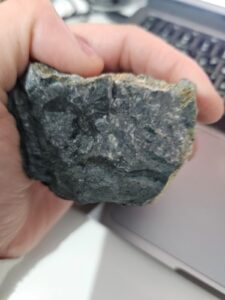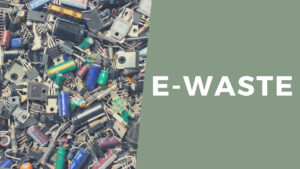To reduce carbon emissions will take more than powering the global economy purely with renewable energy. Although the sun, wind and water will play a critical role when moving forward, their impact can be strengthened by a circular economy.
Technology focused companies like Canadian listed Mineworx (TSX.V:MWX) are making a significant contribution to the circular economy by not only taking care of the waste in terms of recycling, but limiting the impact of primary production on the environment.
Mineworx is leading the pack of new cleantech companies that are taking the world by storm. Their concept makes economic sense. At the same time it attracts massive interest from ESG investors by actually improving the state of the environment, and not just mitigating the impacts.

Kickstarting the circular economy requires innovative solutions to minimise unnecessary waste and improve efficiencies. Recycling materials like PGMs and gold will not only cut carbon emissions, but it will reduce costs and limit the environmental footprint that primary extraction methods are responsible for.
The recent COP26 Climate Change Conference held in Glasgow in the UK, emphasised the need for rapid solutions to reverse the adverse impacts of climate change. Despite criticism from various quarters, COP26 could well become a turning point in history.
The urgency among delegates to transform a world economy addicted to fossil fuels was palpable in Scotland. This sudden haste to implement measures of limiting global warming to less than 2 degrees Celsius, preferably to 1.5 degrees Celsius, decided upon in Paris in 2015, comes on the back of stark evidence that the world is spiralling towards disaster.
A range of calamitous natural disasters (including the outbreak of a global pandemic) over the past few years, is an indication that all is not well on planet earth. The conundrum for world leaders is that a reduction of carbon emissions means tampering with a global economy that has been firing on all cylinders since the industrial revolution.
Ironically, the energy needed to keep the fire of a perpetually expanding economic system burning, are fossil fuels – the main culprits causing the earth to overheat. Naturally, the first response would be to replace the dirty energy source with technologies that are clean and environmentally friendly.
Renewable energy is therefore punted as the magic cure that would enable the world to decarbonise and remain within the 1.5 to 2 degree Celsius guideline. Even if renewable energy is vital in this process, starving the engine of its toxic source of power is only part of the remedy. Renewable energy is half a dose. The other half is a combination of recycling, regurgitating, and re-using. In addition to solar panels, wind turbines and hydropower stations, the world needs a circular economy to completely heal the wounds of its past.
The circular economy is driven by different inputs and the outcome is to reduce waste to a minimum. These factors include sharing, leasing, reusing, repairing, refurbishing, and recycling existing materials and products for as long as possible. In this way, the life cycle of different products and materials is extended significantly.
For example, the re-mining and recycling of gold and the Platinum Group Metals (PGMs) in the mining industry reduces carbon emissions substantially, decreases the environmental footprint of mining operations and improves efficiency.
Waste from mining
During primary production of PGMs (traditional mining) and ore treatment, large amounts of PGMs are lost. Through inefficiencies, waste occurs which also affects the global economy adversely. Moreover, during primary production the PGM content is low considering the high energy that is needed.
In contrast, during secondary exploitation (which includes, for example, liberating PGMs from old diesel catalytic converters) higher PGM concentrations are extracted, between 70% and 100% less energy is consumed, higher recovery yields are achieved, and the environmental footprint, especially of opencast platinum mines, is limited.
Thus, the transition to a greener future, and tackling climate change, will not be possible without investing in a circular economy. Part of that solution is cleantech companies, who through their strategic action, gives credence to calls of decarbonisation, green technology, and a reduced environmental footprint.
Mineworx on the right track
Mineworx (TSX.V:MWX) is a cleantech company that recycles spent diesel catalytic converters in the USA. According to Fornalczyk and Saternus (2009), spent automotive catalysts are the richest PGM secondary resource, being widely exploited for PGM recovery. “It is estimated that processing 2mg of spent automotive catalysts can prevent the mining of 150kg PGM ores,” Fornalczyk and Saternus state in their research.
Mineworx has developed technology that improves on the old smelting methods of recycling PGM’s in furnaces. The company is currently rolling out its revolutionary processing plant in Tennessee in the USA. With an expected rebound in automotive production and increase in demand for platinum this year and the next, companies like Mineworx are on the right track.
According to Johnson Matthey demand for platinum in autocatalysts is forecast to bounce back strongly in 2021, with consumption this year matching or slightly exceeding the 2019 level, and platinum taking an increased share of total autocatalyst PGM demand.
“Globally, platinum use in diesel cars will rise in line with production volumes (forecast to increase by around 14% in 2021, following a 25% decline last year) but will remain at least 10% below pre-pandemic levels.
“While the light duty diesel sector will remain the largest single source of automotive platinum demand in 2021, other market segments will show much faster growth. Demand for platinum in gasoline vehicles is forecast to climb steeply this year, albeit from a low base, as automakers seek to reduce aftertreatment.” All this platinum and palladium are of course prime targets for recycling companies like Mineworx, who do not have to invest large amounts of capital in exploration projects with the risk of not finding sufficient ore bodies.
Mineworx rolls out processing technology
Stage 4 testing commenced at the beginning of November.
The goal of Stage 4 is to review the current design under increasing throughput volumes to identify operational issues and system bottlenecks that could result in inefficiencies in a commercial scale plant. This testing will provide information on design modifications that will need to be incorporated into the final design of the commercial scale plant.
Companies like Mineworx will play an increasingly important role as the world moves into a new reality. Recycling is the foundation of a circular economy, so important in the economic transformation. According to Dame Ellen MacArthur, 45% of global greenhouse gas emissions come from the way we manufacture and produce.
“If we want to fix the climate, we have to transform the economy, and not only the way it is powered,” says MacArthur. According to the Ellen MacArthur Foundation’s Completing the Picture: How the Circular Economy Tackles Climate Change report, a systemic approach to redefining value creation has to be adopted to address current emissions.
This approach will have to rely on the three fundamental circular economy principles of eliminating waste, circulating materials and products, and regenerating nature.
Leading companies like Mineworx are starting to harness the opportunities on offer and scaling up circular innovations is now a priority.
“The current response to the global climate crisis represents an incomplete picture. Putting in place a circular economy is a fundamental step towards achieving climate targets. Such a shift moves us beyond efforts to minimise emissions in our extractive linear system. It offers a systematic response to the crisis by both reducing emissions and increasing resilience to its effects.
The benefits encompass meeting other goals such as creating more liveable cities, distributing value more widely in the economy, and spurring innovation. These attributes make the circular economy a potent contributor to achieving zero carbon prosperity” the report states.
The challenges of flipping an entire global economic system seems insurmountable, but the incentives to meet these problems are unquestionable. To date, efforts to tackle the crisis have focused on a transition to renewable energy, complemented by energy efficiency. Though crucial and wholly consistent with a circular economy, these measures can only address 55% of emissions. The remaining 45% comes from producing the cars, clothes, food, and other products we use every day.
And this is where companies like Mineworx will contribute to complete the picture of carbon reduction. By transforming the way we extract and recycle minerals and materials, and by adapting our thinking around the future of mining, the goal of net zero in 2050 looks more realistic. Efficiently extracting resources from the ground should no longer remain the primary goal. Mining companies need to combine efficient mining methods with environmentally friendly re-mining innovations and cost saving recycling opportunities from existing products. In this way, we can slowly claw back the environmental losses for which we are all responsible.






